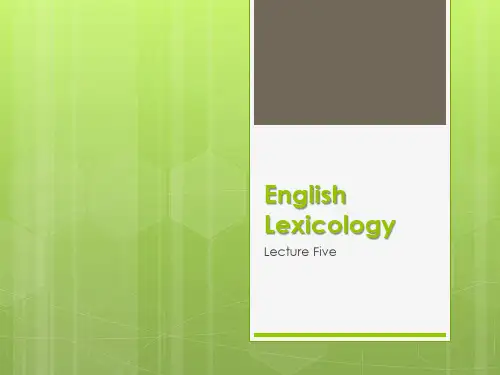英语词汇学教程课件第5章English Lexicology 5下
- 格式:ppt
- 大小:533.00 KB
- 文档页数:34
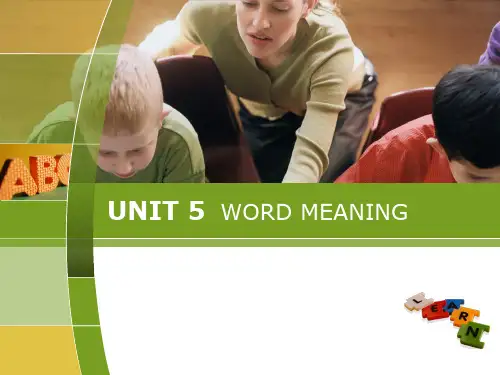

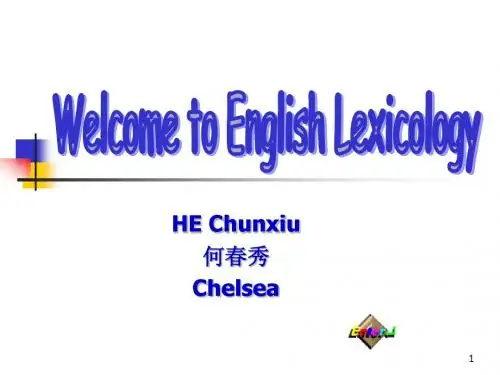
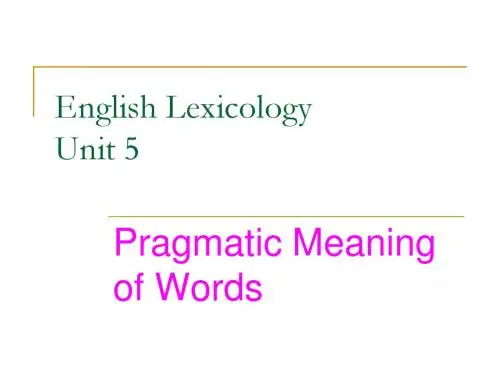
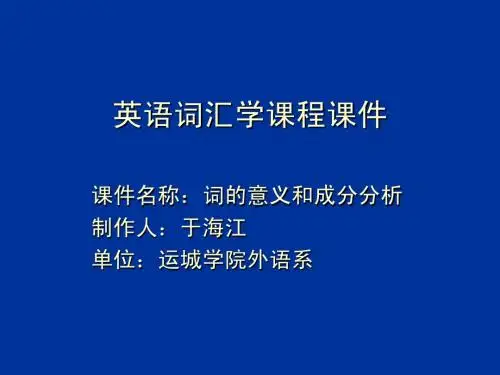
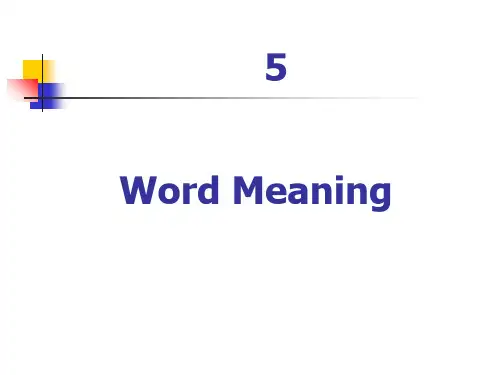
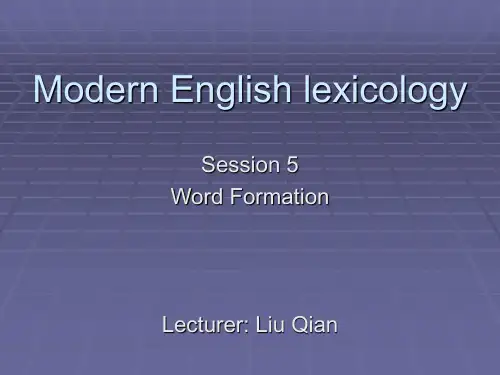
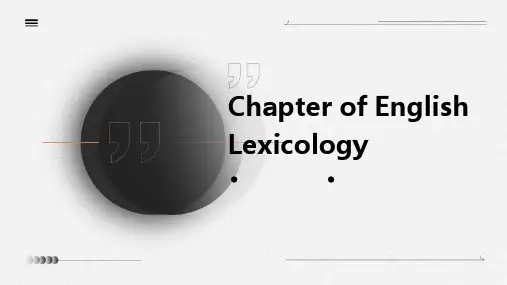
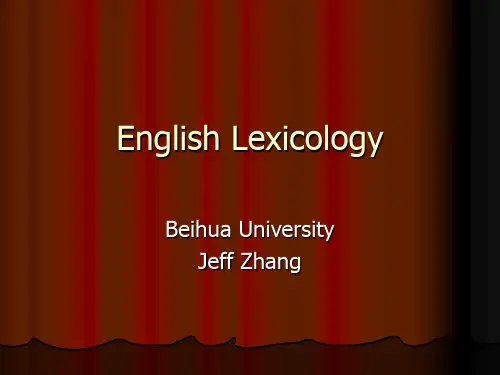
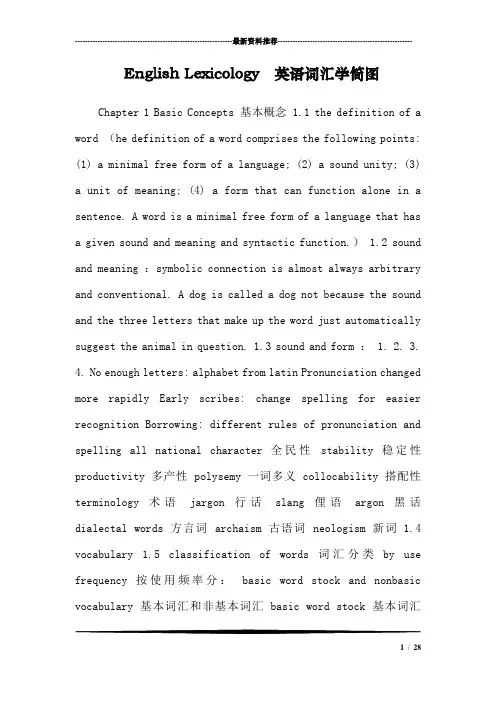
---------------------------------------------------------------最新资料推荐------------------------------------------------------ English Lexicology 英语词汇学简图Chapter 1 Basic Concepts 基本概念 1.1 the definition of a word (he definition of a word comprises the following points:(1) a minimal free form of a language; (2) a sound unity; (3)a unit of meaning; (4) a form that can function alone in a sentence. A word is a minimal free form of a language that has a given sound and meaning and syntactic function.) 1.2 sound and meaning :symbolic connection is almost always arbitrary and conventional. A dog is called a dog not because the sound and the three letters that make up the word just automatically suggest the animal in question. 1.3 sound and form : 1. 2. 3.4. No enough letters: alphabet from latin Pronunciation changed more rapidly Early scribes: change spelling for easier recognition Borrowing: different rules of pronunciation and spelling all national character 全民性stability 稳定性productivity 多产性 polysemy 一词多义 collocability 搭配性terminology 术语jargon 行话slang 俚语argon 黑话dialectal words 方言词 archaism 古语词 neologism 新词 1.4 vocabulary 1.5 classification of words 词汇分类by use frequency 按使用频率分:basic word stock and nonbasic vocabulary 基本词汇和非基本词汇basic word stock 基本词汇1/ 28obvious characteristics 明显的特点nonbasic vocabulary 非基本词汇by notion 按概念分: content words and functional words 实义词和功能词 native words 本地词 borrowed words 外来词neutral in style文体上中性by origin 按起源分: native words and borrowed words 本地词和外来词frequent in use 使用频繁denizens 同化词aliens 异形词translation-loans 译借词semantic-loans 借义词---------------------------------------------------------------最新资料推荐------------------------------------------------------ Chapter 2 DevelopmentIt is assumed that the world has approximately 3, 000 (some put it 5, 000 ) languages, which can be grouped into roughly 300 language families on the basis of similarities in their basic word stock and grammar. Prussian 普鲁士语 Lithuanian 立陶宛语 Polish 波兰语 Czech 捷克语Bulgarian 保加利亚语 Slovenian 斯洛文尼亚语 Russian 俄语Persian 波斯语 Bengali 孟加拉国语 Hindi 印地语 Romany 普吉赛语Balto-Slavic波罗的海-斯拉夫语Eastern set:东部诸语族:Indo-Iranian印度-伊朗语Armenian 2.1 Indo-European 印欧语亚美尼亚语Albanian 阿尔巴尼亚语 Celtic 凯尔特语Italic Western set:西部诸语族:意大利语Scottish 苏格兰语 Irish 爱尔兰语Welsh 威尔士语Breton 布里多尼语Portuguese 葡萄牙语Spanish 西班牙语 French 法语 Italian 意大利语 Roumanian 罗马尼亚语 Norwegian 挪威语 Icelandic 冰岛语 Danish 丹麦语Swedish 瑞典语 German 德语 Dutch 荷兰语 Flemish 佛兰德语English 英语Latin 拉丁语言Hellenic 希腊语——GreekGermanic日耳曼语Scandinavian languages 斯堪的纳维亚语3/ 28Old English (450--1150) —— Anglo-Saxon 古英语盎格鲁-撒克逊语50000-60000 words 5万~6万间词汇 Highly inflected 高度转折 complex endings 复杂的结尾 vowel changes 元音变化 2.2 Historical review 历史概述Middle English (1150-1500) 中古英语French words 法语词汇leveled endings 水平结尾Early Modern English (1500-1700) 早期现代英语Modern English (1500-up to now) 现代英语Borrow 借词new words 新词no endings 无结尾Late Modern English (1700-up to the present) 晚期现代英语 from a synthetic language (Old English) to the present analytic language。
